January 22, 1861 – Pennsylvania Refinery produces Kerosene –
The first U.S. multiple-still refinery was brought on-stream one mile south of Titusville, Pennsylvania, by William Barnsdall, who had drilled the second successful well after Edwin Drake’s first U.S. oil discovery.
Barnsdall and partners James Parker and W.H. Abbott spent about $15,000 to build six basic stills for refining kerosene. Much of the equipment was purchased in Pittsburgh and shipped up the Allegheny River to Oil City. The refinery produced two grades of kerosene, white and the less the expensive yellow.
January 22, 1910 – Standard Oil of California strikes Oil
Standard Oil Company of California (Socal) drilled its first successful oil well, a gusher in Kern County that initially produced 1,500 barrels of oil a day from the Midway-Sunset field, The discovery came after the 1906 merger of Pacific Coast Oil Company (see First California Oil Well) and Standard Oil Company of Iowa to create Socal.
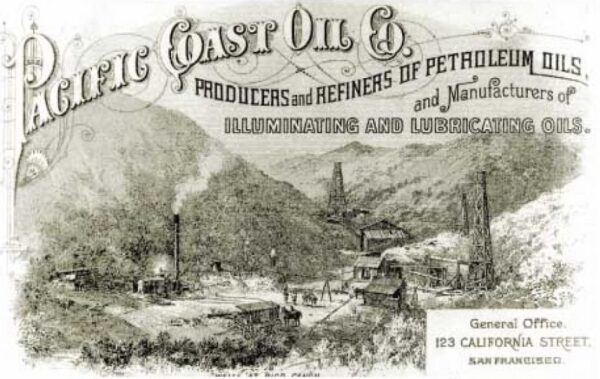
Standard Oil Company of California (Socal) began in 1879 as the Pacific Coast Oil Company, and in 1981 renamed Chevron. Image courtesy Chevron.
The new company needed more oil reserves after it had “stepped up its marketing efforts, particularly in gasoline sales, which nearly doubled between 1906 and 1910,” according to a company history. “Until now, Standard had left the hunt for oil to others.”
The U.S. Supreme Court in 1911 ordered Socal separated from its parent, Standard Oil Company of New Jersey. After absorbing Standard Oil of Kansas in 1961 and making other acquisitions, the California company in 1984 rebranded as Chevron, headquartered in San Ramon.
January 23, 1895 – Standard Oil closes Oil Exchanges
Standard Oil Company of New Jersey’s purchasing agency in Oil City, Pennsylvania, notified independent oil producers it would only buy their oil at a price “as high as the markets of the world will justify” — and not “the price bid on the oil exchange for certificate oil.”
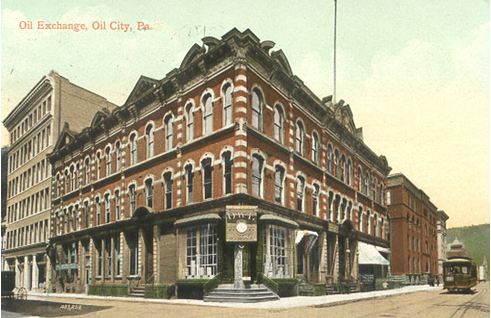
The Oil City, Pennsylvania, Oil Exchange incorporated in 1874. By 1877, it was the third largest financial exchange in the United States.
Oil City’s exchange had become the third largest financial exchange of any kind in America, behind New York and San Francisco. But with the Standard Oil Company buying 90 percent of oil production and setting its own price for certificates, all other oil exchanges soon closed.
Learn more in End of Oil Exchanges.
January 23, 1957 – Wham-O launches a New Petroleum Product
One of the earliest mass-produced products made from plastic, the “Frisbee” was introduced by Wham-O Manufacturing Company of California. The toy originated in 1948 when a company called Partners in Plastic sold its “Flyin’ Saucers” for 25 cents each. In 1955, Richard Knerr and Arthur “Spud” Melin’s Wham-O bought the rights.
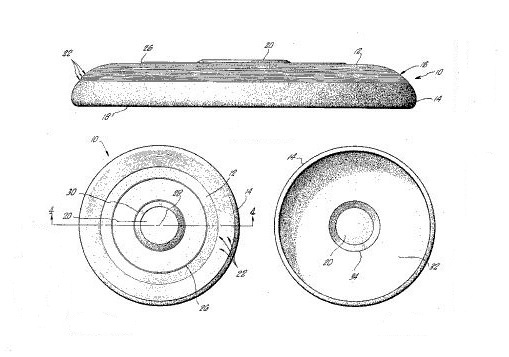
U.S. patent detail of a 1967 polyethylene plastic Frisbee.
The Wham-O founders discovered that Phillips Petroleum had invented a high-density polyethylene (called Marlex). They used the new plastic to meet phenomenal demand for manufacturing Frisbees – and Hula Hoops beginning in 1958.
Learn more in Petroleum Product Hoopla.
January 23, 1991 – Gulf War brings World’s Largest Oil Spill
The world’s largest oil spill began in the Persian Gulf when Saddam Hussein’s retreating Iraqi forces opened pipeline valves at oil terminals in Kuwait. About 11 million barrels of oil would cover an area extending 101 miles by 42 miles and reaching five inches thick in some places.
Iraqi soldiers sabotaged Kuwait’s main supertanker loading pier, dumping millions of gallons of oil into the Persian Gulf. By February, about 600 Kuwaiti wells had been set ablaze. It would take months to put out the well fires, with the last extinguished in early April 1991.
January 24, 1895 – Pure Oil Company founded by Independent Producers –
To counter Standard Oil Company’s market dominance, Pennsylvania oil producers, refiners, and pipeline operators organized what would become a major Chicago-based oil venture. Originally based in Pittsburgh, Pure Oil Company quickly grew into the second vertically integrated U.S. petroleum company after Standard Oil.
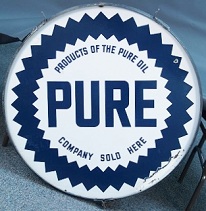
An Ohio firm adopted the old Pennsylvania name.
Beginning in early 1896, Pure Oil marketed its petroleum products by horse-drawn tank wagons in Philadelphia and New York — successfully competing with Standard Oil’s monopoly. The Ohio Cities Gas Company of Columbus acquired Pure Oil and in 1920 adopted the former Pennsylvania venture’s brand name.
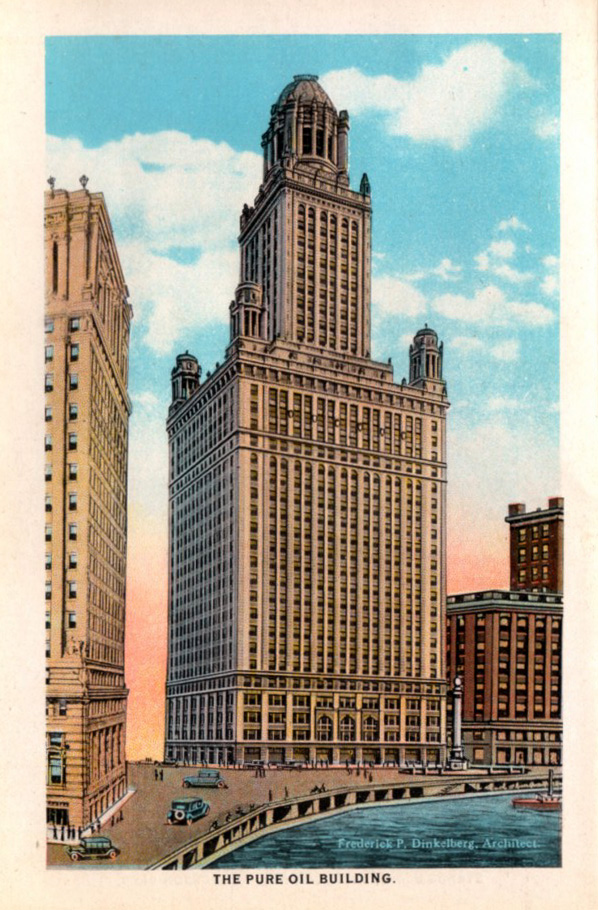
Pure Oil Company in 1926 moved into its new 40-story Chicago headquarters building at 35 East Wacker Drive.
With a new Chicago headquarters opened in 1926, Pure Oil began exploring offshore technologies within a decade. The company developed early freestanding drilling platforms in the Gulf of Mexico.
January 25, 1930 – North Texas Oil Producers form Association
After meeting in Wichita Falls to protest “the recent drastic price cut in crude oil, inaugurated by some of the major purchasing companies,” 50 independent producers organized the North Texas Oil and Gas Association. Other issues included seeking a tariff on foreign oil imports and stopping “hot oil” oilfield thefts. The association merged with the West Central Texas Oil & Gas Association in 1998 to become the Texas Alliance of Energy Producers.
January 26, 1931 – Third Well reveals Extent of East Texas Oilfield
As East Texas farmers struggled to survive the Great Depression, an oil discovery confirmed the existence of a massive oilfield. W.A. “Monty” Moncrief of Fort Worth completed the Lathrop No. 1 well, which produced 7,680 barrels of oil a day from 3,587 feet deep. Geologists at first thought a third oilfield had been found.
Moncrief’s discovery well was 25 miles north of the famous Daisy Bradford No. 3 well of October 1930, drilled by Columbus Marion “Dad” Joiner. It was 15 miles north of the Lou Della Crim No. 1 well, completed at Kilgore three days after Christmas 1930. The 130,000-acre East Texas oilfield would become the largest in the lower-48 states.
Learn more in Moncrief makes East Texas History.
January 28, 1921 – “Vaseline Well” erupts in Oklahoma
After reaching a depth of 3,710 feet, drillers of the W.C. Newman well near Lamar, Oklahoma, “hit into a strata of oil, the like of which never before, nor since has been found,” reported the Daily Oklahoman in a 1933 retrospective of the well, which “caused oil men to marvel then, as today, since it produces the same Vaseline-like content.”
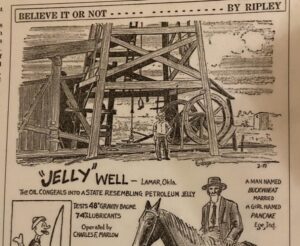
High-viscosity oil from the 1921 Oklahoma well was featured by the syndicated Believe It or Not by Ripley. Illustration courtesy Hughes County Historical Society Facebook Page.
The Hughes County well erupted a dark green oil that “turned into a brilliant yellow when it came into contact with the outside air” and sprayed 200 feet of a semi-solid mass that “hung like gum from the nearby fences, trees and other structures,” noted the newspaper.
“Ordinary pipelines would not carry the oil, so a special line, sandwiched between four steam pipes to heat the almost solid lubricant enabled it to flow to storage tanks,” the article added. Featured as the “jelly” well in the syndicated Believe it or Not by Ripley, by 1933 daily production of 350 barrels of the high-viscosity oil had declined to 15 barrels.
January 28, 1969 – Oil Spill at Santa Barbara, California
After drilling 3,500 feet below the Pacific Ocean floor, a Union Oil Company drilling platform six miles off Santa Barbara suffered a blowout. The accident spilled an estimated 100,000 barrels of oil into the ocean with some reaching southern California’s beaches, including Summerland — where early U.S. offshore petroleum history began in 1896 with wells drilled from piers.
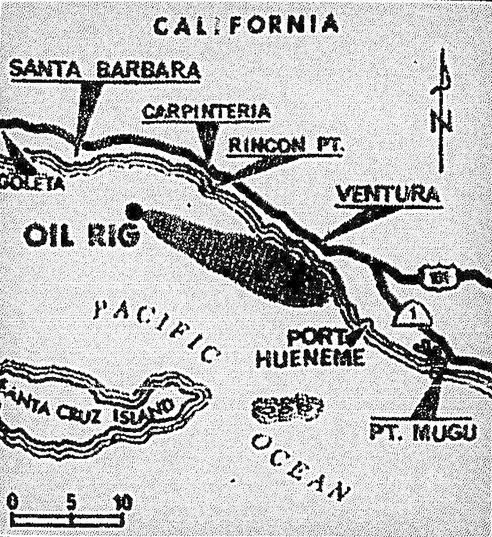
Beyond the 1969 Santa Barbara spill, marine scientists have noted California’s natural oil seeps continue to leak tons of petroleum every day.
The drilling crew had begun to retrieve pipe in order to replace a drill bit when the mud used to maintain pressure became dangerously low, causing a natural gas blowout, according to the University of California, Santa Barbara. The well, which was brought under control after 12 days, turned public opinion against offshore exploration and helped lead to creation of the Environmental Protection Agency (EPA) in December 1970.
Naturally occurring oil seeps in the Santa Barbara Channel have been significantly reduced by offshore oil production, according to “History of Oil in the Santa Barbara Channel,” a 2018 exhibit at the Santa Barbara Maritime Museum.
Learn more in Oil Seeps and the Santa Barbara Spill.
January 28, 1991 – Parker Rig No. 114 becomes Tourist Attraction
Among the biggest drilling rigs in the world, Parker Drilling Company’s Rig No. 114, was erected in a vacant lot in downtown Elk City, Oklahoma, after civic leaders realized that the massive rig, visible from I-40 and historic Route 66, could draw tourists. The Parker rig had once drilled deep wells for testing nuclear bombs.

Parker Rig No. 114 has welcomed visitors to Elk City, Oklahoma, since 1991. Photo by Bruce Wells.
In 1969, Parker Drilling signed a contract with the U.S. Atomic Energy Commission to drill a series of holes up to 120 inches in diameter and 6,500 feet deep in Alaska and Nevada. After the experiments, the company modified its rig to drill conventional wells that set records by reaching beyond four miles deep into the Anadarko Basin.
The 17-story Parker No. 114 today stands in downtown Elk City next to the former Casa Grande Hotel at the intersection of 3rd Street and Route 66. Casa Grande, which opened in 1928 to lodge the highway’s travelers, was added to the National Register of Historic Places in 1995. It also was once home to a natural history museum that included petroleum exhibits.
_______________________
Recommended Reading: Titan: The Life of John D. Rockefeller, Sr. (2004); Plastic: The Making of a Synthetic Century
(1996); Against the Fires of Hell: The Environmental Disaster of the Gulf War
(1992); The Black Giant: A History of the East Texas Oil Field and Oil Industry Skulduggery & Trivia
(2003); Slick Policy: Environmental and Science Policy in the Aftermath of the Santa Barbara Oil Spill (2018);. Your Amazon purchase benefits the American Oil & Gas Historical Society. As an Amazon Associate, AOGHS earns a commission from qualifying purchases.
_______________________
The American Oil & Gas Historical Society (AOGHS) preserves U.S. petroleum history. Become an AOGHS annual supporting member and help maintain this energy education website and expand historical research. For more information, contact bawells@aoghs.org. Copyright © 2024 Bruce A. Wells. All rights reserved.


